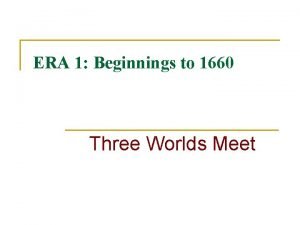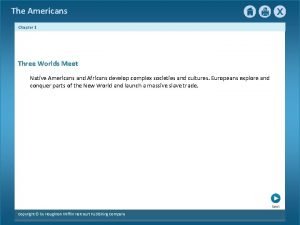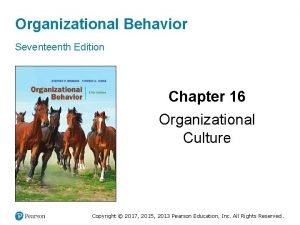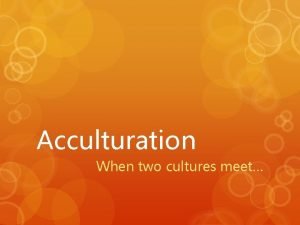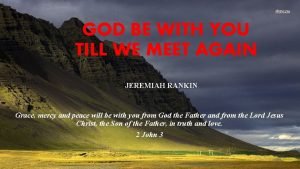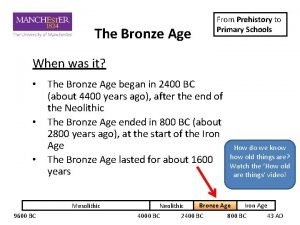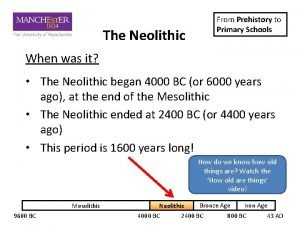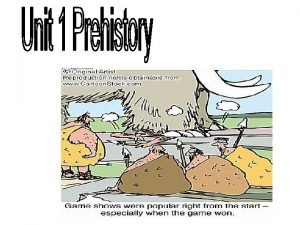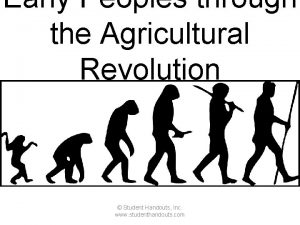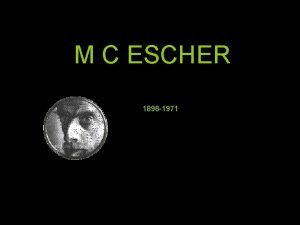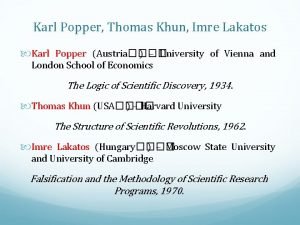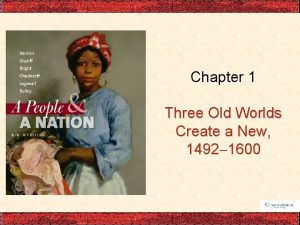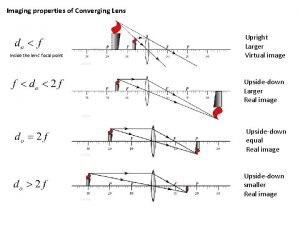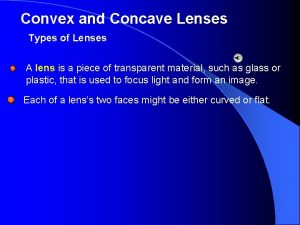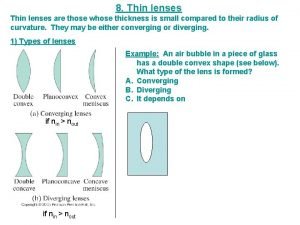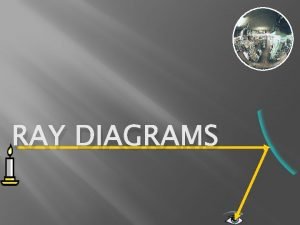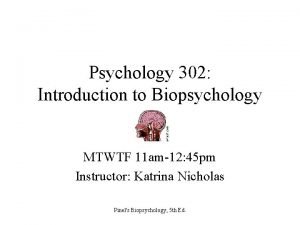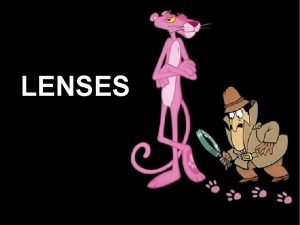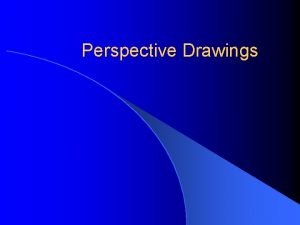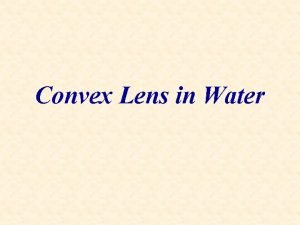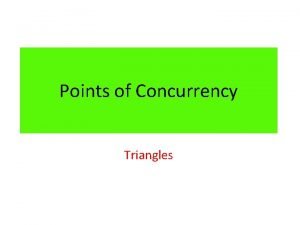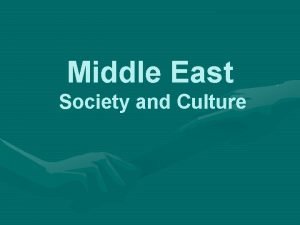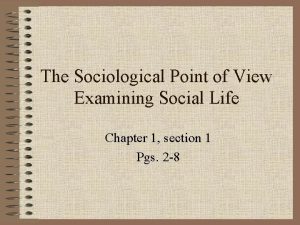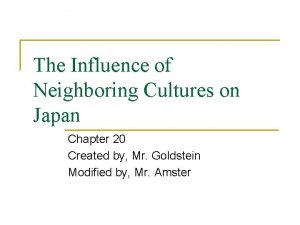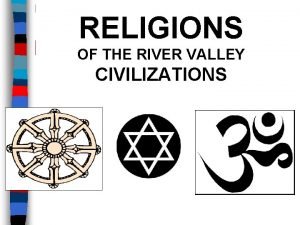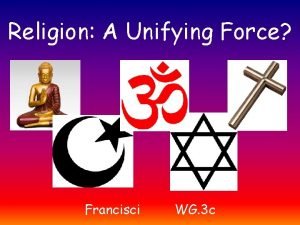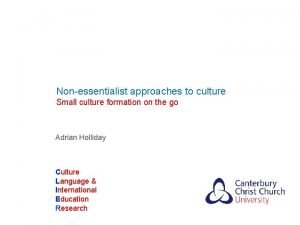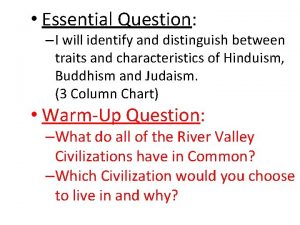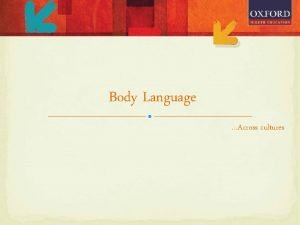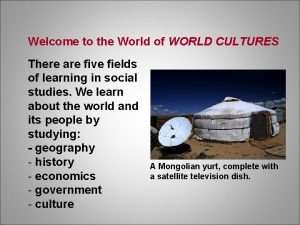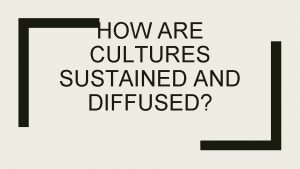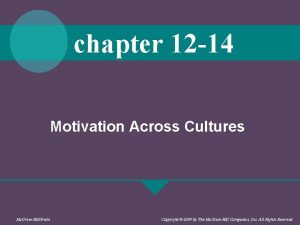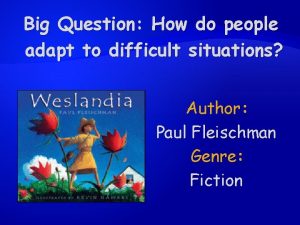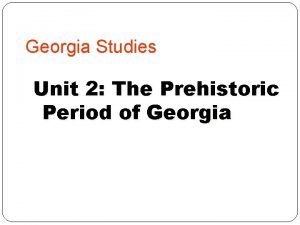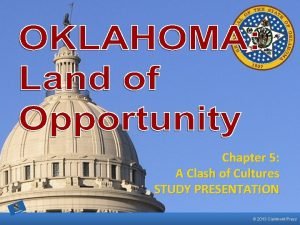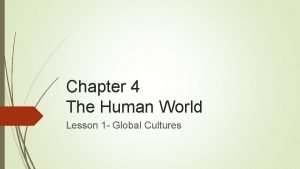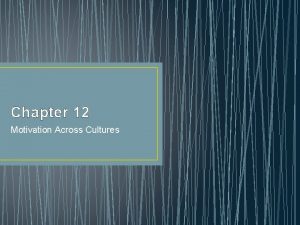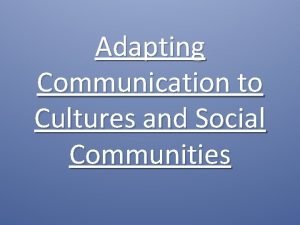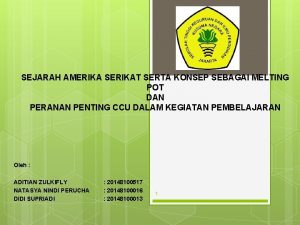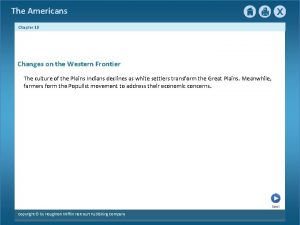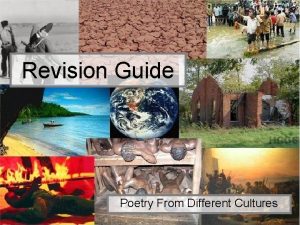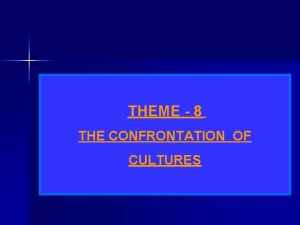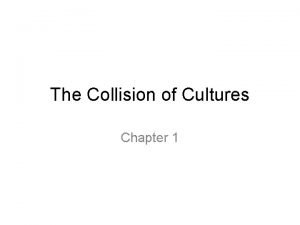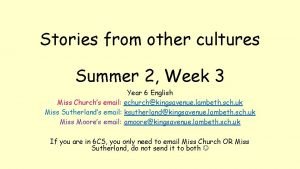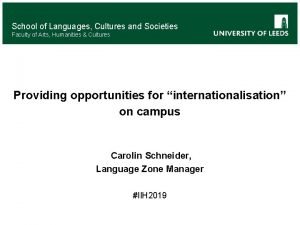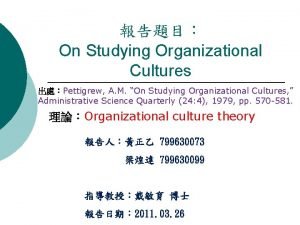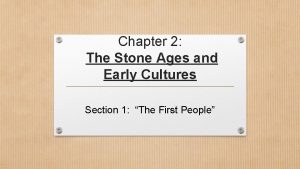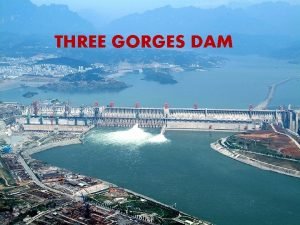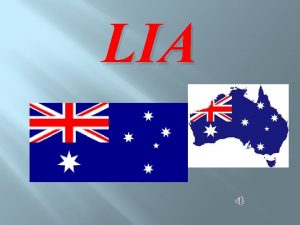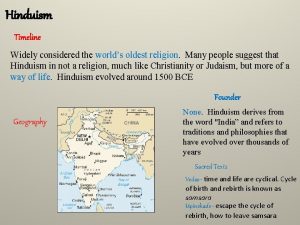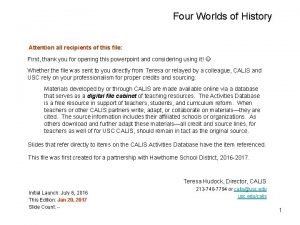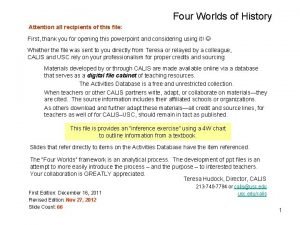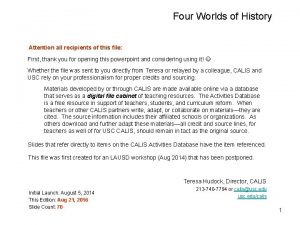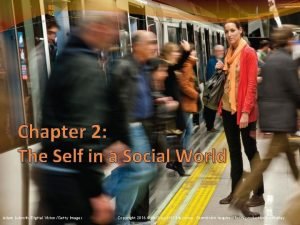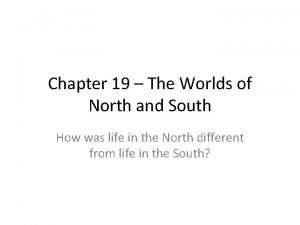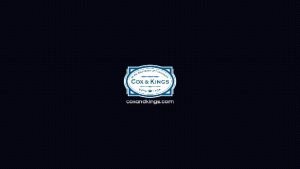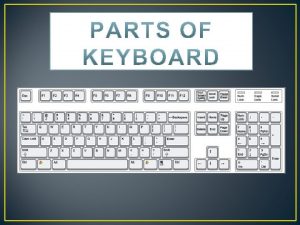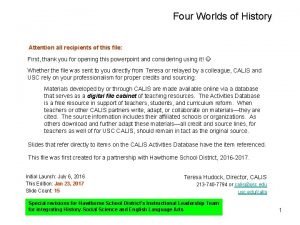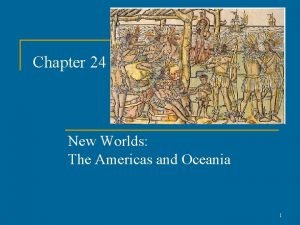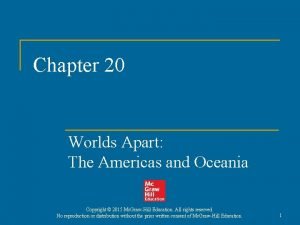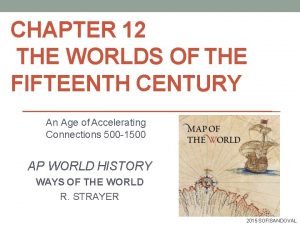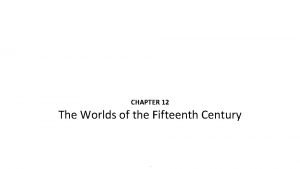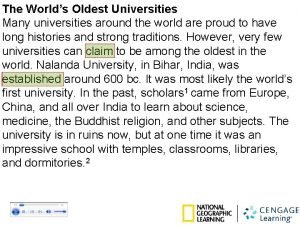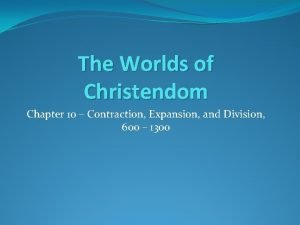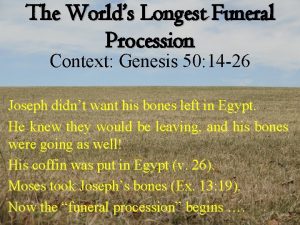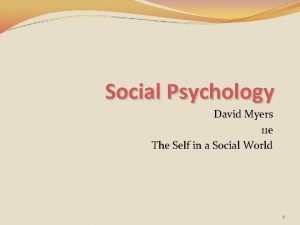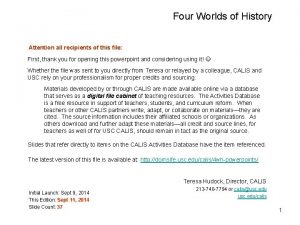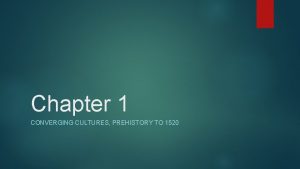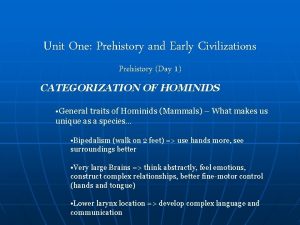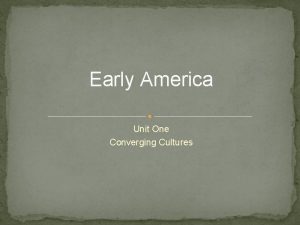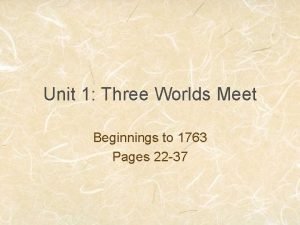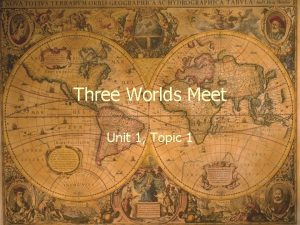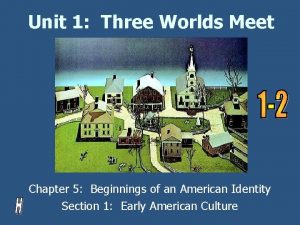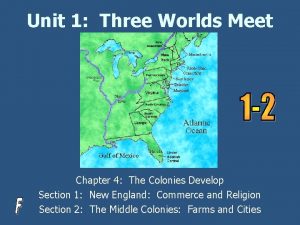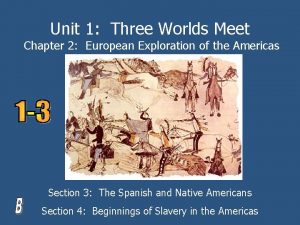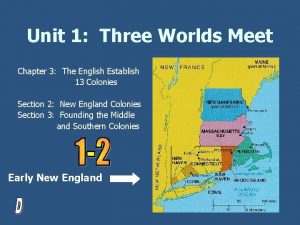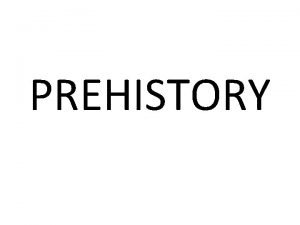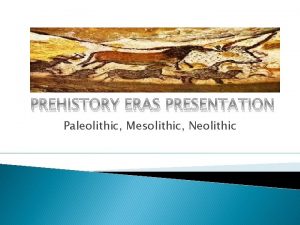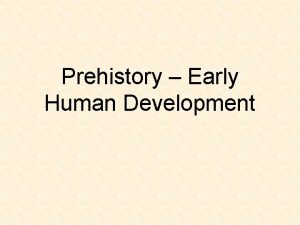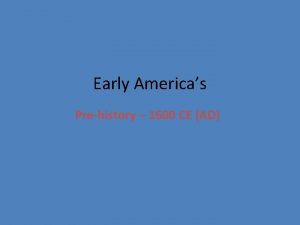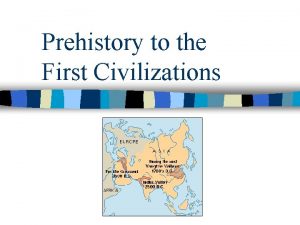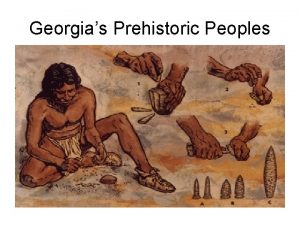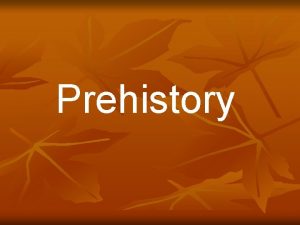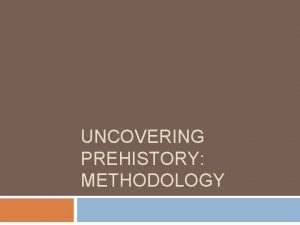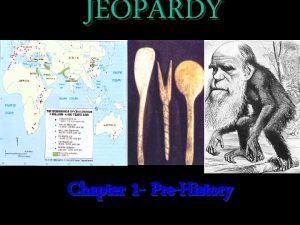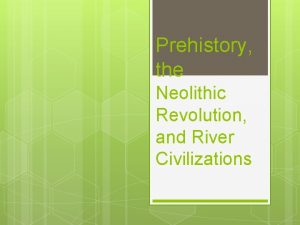Three Worlds Meet Unit 1 Converging Cultures Prehistory




































































































































- Slides: 132

Three Worlds Meet Unit 1

Converging Cultures Prehistory - 1520 Chapter 1

Migration to America �No one knows for sure when the first people migrated to North America �Folsom discoveries tell us that people were here at least 10, 000 years ago or even earlier �Examining DNA helps determine the origin of ancient people �Radiocarbon Dating – to determine how old objects are; done by measuring the radioactivity left in a special type of carbon, called carbon 14, which can be taken from bone or wood

Asian Migration to America • It is believed that people from Asia crossed the Beringia from northern Asia and into Alaska • They did this because they constantly hunted for food and their adventures brought them to the American continent

Early Civilizations of Mesoamerica �Mesoamerica comes from the Greek work meso meaning “middle”; this was located in southern Mexico and central America �The people there learned how to plant & raise crop during the agricultural revolution (9, 000 -10, 000 years ago) �The first crops included pumpkins, peppers, squashes, gourds, and beans

Early Civilizations of Mesoamerica �Maize, also known as corn, was perhaps the most important of all crops because it could be ground into flour to make bread and dried and stored for a long period of time �What happened to nomadic people during the agricultural revolution

The Olmec �Civilization – highly organized society marked by trade, government, the arts, science, and sometimes a written language �Anthropologists believe that the earliest civilization was the Olmec �They emerged between 1500 BC-12 oo. BC near Veracruz, Mexico

The Olmec • They had built villages, temples, and pyramids

The Olmec • They also built enormous 8 -foot heads

The Maya • The Maya emerged around 200 AD in the Yucatan peninsula and expanded in present-day Central America and southern Mexico

The Maya They were very talented in mathematics & engineering which is how they developed one of the most accurate calendars of their time

The Maya • They also built pyramids like other ancient peoples which served as temples • They were the centerpiece of the Mayan cities of Tikal & Chichen Itza • The Mayan were a great civilization but because they were not unified they usually fought wars against each other

The Toltec �After the Mayan civilization disappeared, a new one emerged called the Toltec �They built their city in Tula and they were master architects �They were one of the first Native Americans to use gold and copper for art and jewelry �However around 1, 200 AD they also fell to northern invaders called the Chichimec

The Aztec �One group from the Chichimec called the Mexica, built their city called Tenochtitlan in 1325 �It is located in present-day Mexico City �This group however adopted the name Aztec for themselves from their original homeland: Aztlan �They created a huge empire by using military force and also controlled trade this way �They even brought some captives as human sacrifices in their religious ceremonies

The Aztec Ceremonies

The Hohokam � 300 AD: In central Arizona a group called the Hohokam built a civilization with an elaborate system of irrigation canals �Their canals carried water hundreds of miles away to their farms �They grew corn, cotton, beans, and squash �The Hohokam culture flourished for more than 1, 000 years � 1300: they began to abandon their irrigation system because of floods and by 1500 they vanished

The Anasazi � 700 AD - 900 AD: the people of the Four Corners area came together to create a civilization � Utah � Colorado � Arizona � New Mexico �They were called the Anasazi – “ancient ones” �They built basins and ditches to channel rain in their harsh desert environment

The Anasazi • 850 – 1100: they built large, multi-story buildings of adobe with connecting passageways • It also included circular ceremonial rooms called kivas • Spanish explorers called these structures pueblos – Spanish for “village”

The Adena & Hopewell Cultures �These people of the eastern woodlands developed woodworking tools such as stone axes and gouges �They built dugout canoes and made nets to snare birds �They also made clay pots � 1000 BC: these people began burying their dead under massive dome-shaped mounds of dirt �The Adena lasted from 1000 BC until 200 BC �The Hopewell lasted from about 200 BC until 400 AD

The Mississippian Culture � 700 AD - 900 AD: agricultural technologies began to spread through the Mississippi River �This created another new culture called the Mississippean �They were great builders who left an 8 mile stretch of remains in Missouri �Their main city was home to about 16, 000 people and they also had pyramids

Native American Cultures Chapter 1 – Section 2

The West - Southwest �By the time the Europeans arrived, Native Americans were scattered into many small groups �The Southwest inhabited the descendants of the Anaszi and the Hohokam �They included the Zuni, Hopi, and other Pueblo peoples �They depended on corn to survive

Southwest �When a man married, he joined the household of his bride’s mother �Men’s and women’s work was separate � Men farmed and herded sheep and performed most ceremonies, made moccasins, and wove clothing and blankets � Women had to take care of the house and they also crafted pottery and baskets, and hauled water, they also helped men in farming and constructing houses

Southwest • When boys turned 6 they joined the kachina cult � Kachina – good spirit • They believed that the kachina visited their town each year with messages from the gods • These cult members wore masks symbolizing the spirits and they also danced to bring the spirits to the town

Southwest �The more famous groups, the Apache & Navajo, also inhabited the southwest �The Apache remained nomadic �The Navajo settled down and learned how to grow corn, beans, and squash

Pacific Coast �This region included many different groups such as the Tlingit, Haida, Kwakiutls, Nootkas, Chinook, and Salish peoples �They occupied the lands from present-day Alaska down to Washington state �They did not practice agriculture and luckily for them they had forests nearby for lumber �They built homes, canoes, made ceremonial masks, and totem poles

Pacific Coast • Between the Sierra Nevada & Rocky Mountains the climate was drier • These groups (the Ute and Shoshone) live a nomadic life • The land was too arid (having little or no rain) so they roamed in search for food

Pacific Coast • In California, there were other groups who enjoyed wildlife and a mild climate • The Pomo gathered acorns, caught fish, and snared small game and birds

The Great Plains �These people were influenced by Mississipean & Hopewell cultures and they lived near the Missouri and other rivers �They practiced agriculture up until the 1500 s where it is believed that they began living a nomadic life �This change could have been caused by drought or war �They included the Pawnee, Kansas, and Iowa peoples

The Great Plains • The Sioux people and others changed drastically after the began taming horses • The Spanish brought horses in the 1500 s and over the years horses either escaped or were stolen • The Sioux encountered and mastered these horses and in the process became some of the world’s greatest mounted hunters and warriors

The Great Plains �Sioux men gained achievement through bravery in hunting and war �They could gain more fame by scalping their enemies they had killed �But the greatest achievement of all was through a nonviolent act called “counting coup”

Counting Coup • This was a process where a warrior would charge into a group of the enemy • Then he would just touch one of them with a stick • This was meant to humiliate the enemy and then gallop away

The Far North �Inuit – were the most northern and widespread of Native Americans and their territory stretched across the Arctic from present-day Alaska to Greenland �The Aluet settled in Alaska as well �These two groups depended heavily on hunting such as seals, walruses, whales, polar bears, caribou, musk oxen, and other animals �They developed harpoons, the kayak, the dogsled, boots with spikes for walking on ice, and special goggles to prevent snow blindness

Eastern Woodlands �East of the Mississippi and south of the Great Lakes �Almost all of the Native Americans here provided for themselves by combining hunting and fishing with farming �They ate a lot of deer meat with corn, beans, and squash �The deer hide was also used for clothing

People of the Northeast • Most of the Northeast people were divided into two major language groups • Those who spoke Algonquian • Those who spoke Iroquoian

Peoples of the Northeast �Algonquian-speaking peoples: � Those located in the New England territory � Wampanoag in Massachusetts � Narragansett in Rhode Island � Pequot in Connecticut � Powhatan Confederacy in Virginia � Delaware along the Delaware River � Shawnee in the Ohio River Valley �Some Algonquian words used in English today: hominy, moccasin, papoose, etc.

Peoples of the Northeast �Iroquoian-speaking people included: � The Huron � Neutral � Erie � Wenro � Seneca � Cayuga � Onondaga � Oneida � Mohawk

Peoples of the Northeast �Many of these people practiced slash-and-burn agriculture by cutting down parts of forests and then burning the cleared land to make it more fertile �They used different types of houses such as longhouses and wigwams

Longhouse Barrel-shaped roofs Large and rectangular

Wigwams Either conical or dome-shaped Were made using bent poles Covered with hides or bark

Iroquois League �The Algonquian and Iroquois people shared some common traits such as decorating their belts (wampum) with white and purple shells �They both viewed land as a resource to be used for the entire group �They also believed that the land was not for one person to buy or sell

Iroquois League �All Iroquoian people had similar cultures and lived in large kinship groups – extended families � This was headed by the eldest woman of the clan � Women occupied positions of power and importance � They were responsible for the planting and harvesting of crops � Up to 10 related families lived together in each longhouse

Iroquois League �Despite their similar cultures they still fought wars against each other � 5 nations in New York (Seneca, Cayuga, Onondaga, Oneida, and Mohawk) formed an alliance known as the Iroquois League �A shaman and a chief of the Mohawk founded the league because they were worried that war was tearing the five nations apart �These leaders were all men but they were all appointed by women

People of the Southeast �They almost all lived in towns where women did most of the farming and men hunted deer, bear, wildfowl and even alligator �They were influenced by the Mississippian culture �The Cherokee were the largest group and lived in what is today North Carolina and eastern Tennessee �They were Iroquoian speakers along with the Choctaw, Chickasaw, Natchez, and Creek

African Cultures Chapter 1 – Section 3

West Africa • Between the 400 s & 500 s there were 3 great empires that rose and fell in West Africa � Ghana � Mali � Songhai

Lay of the Land �Africa’s geography determined where empires would thrive �Sahara – ancient Arabic word meaning desert �Savannah – regions of scrub forest and rolling grassland �The Niger River served as a path for trade and migration

Lay of the Land �Crossing the Sahara was risky but camels allowed merchants to open long-distance routes across the desert �Some things that became available to other parts of the world because of trade: � Gold � Ivory � Ostrich � Feathers � Furs

Islam & West African Civilizations �The most significant of the ideas that traveled to West Africa were the religious ideas of Islam �By 711 Islam had spread all the way across northern African to the Atlantic Ocean �It gained massive acceptance �By the 900 s nomadic traders converted to Islam and carried these ideas across the Sahara and into West Africa

The Lure of Gold �West Africa prospered mainly because of the gold trade �Anyone who conquered African lands quickly found out about the gold and therefore gold was in high demand � 1300 s: 2/3 of the gold in Europe and North Africa came from trade with West Africa

Empires of West Africa - Ghana � 400 s: Ghana was the earliest amongst the empires �It was located between the gold mines of Bambuk and the salt mines of Taghaza �The people called themselves the Soninke �After Muslims conquered North Africa, Ghana’s merchants became very rich �Muslim traders were even allowed to build a mosque in the capital of Kumbi-Saleh

Ghana

Ghana �Despite this success, Ghana’s empire collapsed by the 1200 s � 1100 s: The empire became Muslim but it was hurt by frequent wars with other Muslims of the Sahara �Also, Ghana’s land had become exhausted and its farmers could no longer feed its people �These combined factors weakened Ghana and trade routes bypassed Ghana depriving it of any wealth and success

Empires of the West – Mali �The Malinke people lived east of Ghana and controlled the upper Niger Valley �This allowed them to direct the gold trade �They went on to conquer the Soninke of Ghana and build the empire of Mali � 1300 s: their empire spread east down the Niger River past Timbuktu and west down the Senegal and Gambia Rivers

Mali

Mali �The ruler of Mali was called the mansa �Government: a bureaucracy of scribes and treasurers who lived in the capital city with the emperor �Bureaucracy – a system of government where important decisions are made by state officials and not elected representatives �To stay in power, leaders had to collect tribute from the farmers and send a portion to the capital

Mali �The mansa kept a large army ready and made army leaders important officials in his government to enforce laws � 1300 s: the empire reached its peak under the leadership of Mansa Musa and his brother Mansa Sulayman �But by this time the gold mines had been open to other peoples �This gave rise to Timbuktu as a center of trade and Muslim scholarship

Mansa Musa

Songhai �The Sorko people lived along the middle Niger and built the Songhai empire �They made canoes and fished for a living �They also used their canoes to do trade and gained wealth this way � 800 s: they created an empire �Their ruler was Sonni Ali who used a powerful army of cavalry back by a fleet of war canoes to seize Timbuktu in 1468

Sonni Ali

Songhai �After taking Timbuktu, he pushed into the Sahara and south down the Niger �He captured the town of Jenne and according to legend his army never lost a battle �His son and successor was an ineffectual ruler �He allowed Askiya Muhammad to seize throne

Songhai �Askiya Muhammad: � Was a devout Muslim � Revived Timbuktu as a great center of learning � Encourage more trade across the Sahara � Centralized power in the Songhai capital of Gao �In 1591 the Songhai empire began to declined after Moroccan troops armed with guns and cannons defeated them

Forest Kingdoms of Guinea �The area situated in West Africa’s southern coast is called Guinea �Here we have some small states and kingdoms �The Yoruba & Edo people were a mixture of hunters, farmers, and traders �The farmland allowed farmers to produce so much food that they had a surplus – more than what was needed/used

Benin

Forest Kingdoms of Guinea �The Edo people developed the city-state of Benin in the 11 th & 12 th century �By 1400: Benin was a large, walled city several miles long �Their ruler was called oba �Mid-1400 s: Oba Ewuare put together a powerful army and built Benin into an empire �They sold their captives as slaves to the Portuguese and in a series of civil wars, Benin citizens also fell to slavery to the Portuguese

Central & Southern Africa �Many Central African villages rose becase of its location to the rivers but they also grew wheat and raised livestock �Their societies were matrilineal – tracing your lineage or descent through your mother, rather than your father �Women also played a major role in trade while the men hunted, fished, and raised livestock �Instead of inheriting power through the father, the son inherited power through the mother � Ex: the son of the chief’s eldest sister took the post

Central & Southern African Kongo originated around 1400 along the Zaire River The the fertile soil and abundant rainfall allowed the farmers to produce food surpluses 1500 s: the Kongo king ruled over a large region from the Atlantic to the Kwango River

Slavery �Slavery existed in African society just like it had all over the world �Most of the people had been captives during war or some convicted criminals who served a punishment �In some rare occasions, slaves could purchase their freedom by selling produce they had grown or marry into their captor’s society

The Gold Trade �This also changed slavery in West Africa �The Akan people started mining gold and trading it to the Mali empire �They enquired African slaves for clearing the land mining the gold � 1420 s: when the Portuguese began exploring the west coast of Africa they traded European goods for African gold, ivory, pepper, and palm oil �They also sold enslaved Africans for gold

Sugar & Slavery �Europeans learned about cultivation and processing sugarcane from the Muslims in the 1100 s �Demand for sugar began to rise and about 20% of all calories consumed in Europe came from sugar �They set up sugar plantations on the Mediterranean islands of Cyprus and Sicily which provided the climate and soil for sugarcane growth

Slavery & Sugar Cultivation required heavy manual labor You either pay people to do the work very high wages or find a way to force people to do the work without paying them This encouraged Europeans to use enslaved workers and enter the slave trade

Slavery & Sugar The enslaved people they used were Slavic and Muslim Afterwards they started enslaving Africans to bring them to the Canary & Madeira Islands which was close to Africa However the Europeans had very limited land for plantations; this would change with the discovery of a New World

European Cultures Chapter 1 – Section 4

European Society What was happening in Europe? Pope Urban Ii had called for a holy war against the Muslims living in the Holy Land of Jerusalem They were called the Crusades and they helped shaped European society from that point forward It opened up the doors to another world of spices, silks, and other goods for the Europeans

European Society �The Roman Empire had control of most of Europe, controlling everything from private to public life �By the year 500, it had lost much of its power which isolated western Europe form the rest of the world �Trade declined, cities, bridges, and roads fell into ruin �Life did not extend beyond the tiny villages where they were born �This period is known as the Middle Ages or Medieval Ages

Feudalism �The central government was weakening and this gave rise to a new political system known as feudalism �Feudalism – powerful leaders gave land to nobles in exchange for pledges of loyalty and service �After time these nobles that acquired land would also acquire some powers held by the government �These nobles also raised their own armies, dispensed justice, and even minted coins (made their own money) �In return these nobles swore loyalty and promised to provide knights to the royal army

Manorial System Since the fall of the Roman Empire, many peasants had worked for large landowners because they could not obtain their own land for protection

The Lord’s Manor It included: The lord’s house Pastures for livestock Fields for crops Forest A peasant village Feudalism is the political relationship between nobles Manorialism – the economic ties between nobles

Lord’s Manor

Manorial System �Peasants provided services in exchange for being protected by their lord � Farming the lord’s land � Making various payments of goods �These peasants rarely left the manor �Serfs – people who were bound to the manor and could not leave it without permission �They were not slaves since they couldn’t be sold to someone else

Serf Life �They lived in � Tiny, one-room houses � With dirt floors � A hole in the roof for a chimney � One or two pieces of furniture �They ate: � Coarse bread � Few vegetables � Grain for porridge

An Improving Economy 1000: the invention of a better plow allowed farmers to produce more food The invention of the horse collar allowed farmers to use horses instead of oxen Horses could pull a plow faster than an ox allowing farmers to grow more crops each year

An Improving Economy �The ability to produce a surplus of foods helped to revive trade in Europe and the growth of towns �Warfare and raids by bandits decreased �Roads were soon filled with traders carrying goods to markets

The Church �It had its own laws and dealt with cases related to the clergy, doctrine, marriage, and morals �Disobedience to church laws resulted in sever punishments for common persons and rulers alike �Excommunication – barred people from participating in Church rites

Expanding Horizons • As mentioned before, the Crusades helped open the doors to trade for western Europe • Luxury goods were in demand: � Spices � Sugar � Melons � Tapestries � Silk

Business with Asia �Chinese & Indian merchants traded spices and silk with Arab merchants �Arab merchants traded these good with European merchants �European merchants noticed that Arab merchants only accepted money in payment �They needed a common medium of exchange and it led to the rise of an economy based on money �Demand for gold increased to make coins

The Mongols �The Mongols also helped increase the flow of goods �Mongol horsemen came from Central Asia and built one of the largest empires in world history �They integrated much of Asia’s economy � It broke down trade barriers � Opened borders � Secured the roads against bandings � Encouraged even more trade between Asia & Europe

Expanding Horizons � 1300 s: Europe was importing huge quantities of spices, silks and other goods from Asia �The Mongol empire collapsed in the 1300 s and Asia began to separate into dozens of independent kingdoms and empires �Flow of goods declined �Price of spices rose higher �European merchants looked for a route to Asia that bypassed the Muslim kingdoms �If not by land, perhaps by sea

New States, New Technology �Europeans definitely wanted to find another route to Asia �Feudalism brought about so many wars amongst the different cities/villages that exploring became impossible �Western Europeans also didn’t have the proper technology to attempt to sail to China

Strong States Emerge � 1400 s/1500 s – feudalism started to decline with the help of trade with Asia and the Crusades �Rise of towns/cities provided kings/queens with a new source of wealth they could tax �Rulers could now use their army to open up & protect trade routes �They could also set up common trade laws and a common currency within their kingdoms

Strong States Emerge �Money from trade meant that rulers did not have to depend on nobles for support �Mid-1400 s: 4 strong states emerged � Portugal � Spain � England � France �Portugal was the earliest to set up voyages for exploration

The Renaissance Spurs Discoveries �An intellectual movement had sprung up around the same time these new states began to emerge �Renaissance – “rebirth”, in French �It began around 1350 and lasted until around 1600 �It referred to a rebirth of interest in the classical cultures of ancient Greece & Rome

The Renaissance Scholars rediscovered works of philosophers, geographers, and mathematicians They began to read works by Arab scholars It produced spectacular works of art It also marked a renewed commitment to learning and helped to trigger a scientific revolution

New Technology �To find a water route to China, Europeans needed navigational instruments that would enable sailors to travel out of sigh of land still find their way home �Astrolabe – a device invented by the ancient Greeks, refined by Arab navigators � It uses the position of the sun to determine direction, latitude, and local time �Compass – device which showed the direction of magnetic north

New Technology These tools were very important in navigation but they also needed strong ships to help for smooth sailing Lateen Sails – made it possible for ships to sail against the wind

New Technology Another great invention was the caravel Small vessel capable of carrying about 130 tons of cargo It required very little water to sail

Portuguese Exploration Portuguese explorers became the first Europeans to find a sea route to Asia 1419: Prince Henry of Portugal also known as Henry the Navigator set up a center for astronomical & geographical studies in Portugal He invited mapmakers, astronomers, and shipbuilders from around the Mediterranean world to come there to study and plan explorations

Portuguese Exploration 1420: Portuguese explorers started mapping Africa’s west coast 1488: Bartolomeu Dias, a ship commander, reached the southern tip of Africa 1429: Vasco da Gama commanded 4 ships from Portugal, around Africa, then to India The water route had been found!

Europe Encounters America Chapter 1 – Section 5

Vikings Arrive in America �Contrary to popular belief, Christopher Columbus was not the first European to set foot in the Americas �Vikings (people who came from Scandinavia) were a Norse group who made it here long before �Late 700 s: longboats (Viking ships) ventured outward from their Norse homeland �Most of the Vikings headed south where they traded with other people, even invading them �Others crossed the Atlantic Ocean

Vikings Arrive in America �Sometime around 1000 BCE: Leif Ericsson and 35 men landed in Newfoundland �They tried to set up colonies there but they failed for a few reasons �The Native Americans opposed them �Vikings at this time did not have better weapons than the Natives �Europeans in later years will arrive with weapons of gunpowder

Leif Ericson

Spain Sends Columbus West �The Renaissance renewed the European interest in America �Many European states were eager to find a water route to Asia �Christopher Columbus, an Italian explorer, was sent on a mission by the king and queen of Spain to find this water route

New Geography �Around the 1400 s the only labeled bodies of land on all maps were that of Africa, Europe, the Middle East, and Asia �Then a book appeared that would revolutionize European exploration � 12 centuries earlier, a Greek-educated Egyptian geographer/astronomer Claudius Ptolemy had drawn maps of a round world �It was complete with 360 lines of longitude

Ptolemy’s Geography �It was rediscovered in 1406 and printed in 1457 �European mariners also consulted the work of Arab geographer al-Idrisi who traveled widely in the Middle East � 1154: he published a geographical survey of as much of the world as was then known to Europeans and Muslims

Columbus’s Plan �Ptolemy’s Geography had some serious understatements about the world �He made the world seem much smaller than it actually was �Columbus on the other hand thought that Spain and India were so close together that he could get there within a few days’ time

Columbus’s Plan �At first Columbus went to the Portuguese to get financial backing from them �They agreed to support him financially �However then news broke that Bartolomeu Dias had rounded the southern tip of Africa �The Portuguese lost all interest in supporting Columbus

Columbus’s Plan �So Columbus turns to his brother, Bartholomew who was a respected mapmaker in Europe �They first went to the royalty of England France and they found no luck there �Then they turned their attention to Spain �Columbus promised King Ferdinand & Queen Isabella wealth and many converts to Catholicism � 1492: the king and queen agreed to support Columbus

The First Voyage August 1492: the Nina, the Pinta, and the Santa Maria set sail First he and his men land in the Canary Islands to take fresh supplies After battling the Atlantic Ocean they reached the Caribbean and landed in the Bahamas, one what is today San Salvador Island

The First Voyage �They encounter the Taino people �He called them Indians because he thought he had reached the Indies �He noticed that some of the local people had a small piece of gold “hanging from a hole which they have in their nose” �He soon learned that the gold came from “a king who had large vessels of it, and possessed much gold”

The First Voyage He was very eager to find this gold so he kept searching for it His search brought him to the island of Cuba and Hispaniola (Haiti & Dominican Republic) He mistakenly concluded that Cuba was the coast of China and Hispaniola was Japan

Columbus’s Reaction to the Natives �Upon meeting the Natives, Columbus said that “They are artless and generous with what they have, to such a degree as no one would believe but he who had seen it. Of anything they have, if it be asked for, they never say no, but do rather invite the person to accept it, and show as much lovingness as though they would giver their hearts”

Natives Reaction to Columbus �Natives were just as curious about Europeans as they were of the Natives “The people kept coming down the beach, calling to us and giving thanks God. Some brought us water, some food; others, seeing that I did not wish to go ashore, swam out to us. . One old man climbed into the boat, and the others, men and women, kept shouting ‘Come and see the men who have come from Heaven; bring them food and drink’”

Columbus’s First Voyage �On Christmas Eve, the Santa Maria struck a reef off Hispaniola and broke apart �He and his crew built a small fort called a La Navidad and had 40 crew members go and look for gold �March 1493: Columbus returned to Spain with gold, parrots, spices, and Native Americans �He was awarded with titles such as “Admiral of the Ocean Sea” & “Viceroy and Governor of the Indies” �He promised the King and Queen with as much gold as they want

Columbus’s Later Voyages �This time he goes back with 17 ships and over 1, 200 Spanish colonists �He learns that the men he left behind from his 1 st voyage had been killed and their fort destroyed �Many of the colonists he brought over were nobles who wanted to get rich instantly �They did not want to work let alone do manual labor �They accused Columbus of misleading them with false promises of gold, many headed back to Spain to complain

Columbus’s Later Voyages �In an attempt to save his reputation, Columbus found a place that had gold they could mine �He enslaved the local Taino Natives and forced them to work for the Spanish: mining and planting crops � 1496: his brother, Bartholomew, in the meantime founded a new town called Santo Domingo closer to the gold mines

Columbus’s Later Voyages �On his 3 rd voyage he wrote: “I believe that this is a very great continent, which until today has been unknown” � 1502: he made one final voyage and mapped the American coastline from Guatemala to Panama before returning back

Spain Claims America �Because of Columbus, Spain was able to send many explorers and settlers to the New World �They explored and inhabited the islands of Cuba, Jamaica, Hispaniola, and Puerto Rico �Eventually they made their way to the American mainland

Treaty of Tordesillas �Since Portugal claimed the right to control the Atlantic routes to Asia, it made things difficult for the Spanish �The Spanish then went to the pope to appeal for a decision to use the Atlantic to go to the New World and colonize

Treaty of Tordesillas � 1493: Pope Alexander VI established the line of demarcation to prevent a war between Spain & Portugal �This is an imaginary north-to-south line running down the middle of the Atlantic �It stated that Spain would control everything to the west of this line �While Portugal would control everything to the east of this line

Treaty of Tordesillas �Later on both countries signed a treaty to resolve their differences on the line of demarcation �Treaty of Tordesillas stated that the line would be moved almost 1, 000 miles to the west �It did 2 things: � Confirmed Portugal’s right to control the route around Africa to India � Confirmed Spain’s claim to the New World � Unknowingly the line was so far out west that it cut through South America, giving Brazil to the Portuguese

Treaty of Tordesillas

Naming America � 1499: an Italian explorer, Amerigo Vespucci, sailed for Spain to the New World �He took the same route as Columbus thinking he landed in Asia � 1501: he sails for Portugal and lands in a different region of the continent �He comes to the conclusion that this could not be Asia and publishes a book �German scholar Martin Waldseemuller says that the land should be named after “Amerigo the discoverer”

Continuing Spanish Expeditions Juan Ponce de Leon, a Spanish governor in Puerto Rico, sailed further north He had heard of a place where a fountain had magical abilities These abilities were believed to have restored a person’s youth He did discover a land full of wildflowers and named this place Florida – land of the flowers

Continuing Spanish Expeditions 1510: Vasco de Balboa was a planter from Hispaniola who wanted to escape his creditors He got on a ship and sailed south and founded a colony on the Isthmus of Panama He heard tales of a “south sea” that led to an empire of gold He became the first European to reach the Pacific coast of America

Continuing Spanish Expedition 1520: Ferdinand Magellan was a Portuguese mariner who worked for the Spanish He later discovered a strait which was later named after him He also sailed into the same ocean as Balboa did The waters seemed so peaceful that he named it that, pacific He died in the Philippine Islands but his crew eventually made it back to Spain They became the first to circumnavigate the globe

The Columbian Exchange The interactions between Europeans and Natives changed the world forever It was known as the Columbian Exchange

From America ~> Europe �Local Native Americans taught the Europeans who arrived there how to farm the local crops �Corn became essential to the Europeans and it eventually made its way back to Europe �As did other crops: pumpkins, beans, sweet potatoes, tomatoes, chili peppers, peanuts, chocolate, and squash

From America ~> Europe �The potato was perhaps the most important discovery for the Europeans �Instead of using rye, they could use potatoes to feed more people on the same piece of land �They also learned new devices invented by Natives � Canoe � Snowshoe � Hammock � Poncho

From Europe ~> America �Native Americans were introduced to wheat, oats, barley, rue, rice, coffee, dandelions, onions, bananas, and oranges �Animals included: chickens, cattle, pigs, sheep, and horses �Technologies: new types of metalworking, new techniques of shipbuilding, and new weapons (firearms)

For Europe ~> America �The worst import was an invisible one �Europeans brought bacteria and viruses that caused many diseases: � Influenza � Measles � Chicken pox � Mumps � Smallpox

From Europe ~> America �It is unfortunate that the cons outweigh the pros �The amount of trade between the two continents were overshadowed �Overshadowed by the amount of disease, military conquests, and slavery that devastated the Native American population
 Three worlds meet quiz
Three worlds meet quiz Chapter 1 three worlds meet
Chapter 1 three worlds meet Organizational cultures often reflect national cultures
Organizational cultures often reflect national cultures What happens when different cultures meet
What happens when different cultures meet Norton worlds together worlds apart
Norton worlds together worlds apart Till we meet till we meet at jesus feet
Till we meet till we meet at jesus feet Prehistory for primary
Prehistory for primary Prehistory vs history
Prehistory vs history Prehistory
Prehistory Prehistory for primary
Prehistory for primary The term prehistory refers to the period before
The term prehistory refers to the period before The lecture from prehistory
The lecture from prehistory What is prehistory
What is prehistory What is prehistory
What is prehistory Castrovalva mc escher
Castrovalva mc escher Popper three worlds
Popper three worlds Three old worlds create a new
Three old worlds create a new Converging lens equation
Converging lens equation Object distance formula
Object distance formula What is tear stream in aspen plus
What is tear stream in aspen plus Ray diagram of concave
Ray diagram of concave Converging lines diagram
Converging lines diagram Converging lens and diverging lens
Converging lens and diverging lens Magnification formula for lenses
Magnification formula for lenses Image formation by convex lens
Image formation by convex lens Converging ils approaches
Converging ils approaches Convex vs concave
Convex vs concave Salt converging lens
Salt converging lens Type of lens
Type of lens A simple magnifier is converging lens of focal length
A simple magnifier is converging lens of focal length Magnifying glass converging lens
Magnifying glass converging lens Converging-diverging
Converging-diverging Ray diagrams for diverging lenses
Ray diagrams for diverging lenses Shuffle left algorithm
Shuffle left algorithm Single pass tubular heater
Single pass tubular heater Converging operations psychology example
Converging operations psychology example Converging operations psychology example
Converging operations psychology example Oreo plate tectonics
Oreo plate tectonics Convex shape image
Convex shape image Shuffle left algorithm
Shuffle left algorithm The converging lines are horizontal lines
The converging lines are horizontal lines Concave lens in water
Concave lens in water Ridge characteristics
Ridge characteristics Converging pointers algorithm
Converging pointers algorithm Which three criteria do binomial experiments meet?
Which three criteria do binomial experiments meet? The place where all three altitudes meet is called the
The place where all three altitudes meet is called the Millet system
Millet system Unit 6 review questions
Unit 6 review questions Sub cultures
Sub cultures Which cultures believe in reincarnation
Which cultures believe in reincarnation Examining social life
Examining social life In what ways did neighboring cultures influence japan?
In what ways did neighboring cultures influence japan? Judaism founder
Judaism founder Which cultures believe in reincarnation
Which cultures believe in reincarnation Which cultures believe in reincarnation
Which cultures believe in reincarnation Small cultures
Small cultures Taste different cultures
Taste different cultures What is culture
What is culture Characteristics of collectivism
Characteristics of collectivism Personal sense of identity
Personal sense of identity Recreational activities across cultures and genders
Recreational activities across cultures and genders Which cultures believe in reincarnation
Which cultures believe in reincarnation All cultures undergo
All cultures undergo Communicating across cultures - ppt
Communicating across cultures - ppt Body language across cultures respuestas
Body language across cultures respuestas How many cultures are there
How many cultures are there How are local cultures sustained
How are local cultures sustained High-context cultures emphasize nonverbal messages.
High-context cultures emphasize nonverbal messages. Chapter 20:1 operating the microscope
Chapter 20:1 operating the microscope Motivation in different cultures
Motivation in different cultures Words from many cultures weslandia answers
Words from many cultures weslandia answers Broth cultures
Broth cultures Pengertian transmisi budaya
Pengertian transmisi budaya Indulgence vs restraint examples
Indulgence vs restraint examples Georgia's prehistoric cultures chart
Georgia's prehistoric cultures chart Chapter 5 a clash of cultures
Chapter 5 a clash of cultures Lesson 1 global cultures
Lesson 1 global cultures Motivation across cultures
Motivation across cultures Social communities include a number of cultures.
Social communities include a number of cultures. Southeastern and gulf cultures
Southeastern and gulf cultures Konsep melting pot
Konsep melting pot Isolation of pure cultures
Isolation of pure cultures Cultures of the mountains and the sea
Cultures of the mountains and the sea Cultures and organizations software of the mind
Cultures and organizations software of the mind Chapter 13 section 1 cultures clash on the prairie
Chapter 13 section 1 cultures clash on the prairie Lilac spelling
Lilac spelling Spoken poetry about cultural relativism
Spoken poetry about cultural relativism Motivation across cultures
Motivation across cultures Knorr cetina epistemic cultures
Knorr cetina epistemic cultures Confrontation of cultures
Confrontation of cultures The collision of cultures chapter 1
The collision of cultures chapter 1 Literacy shed zahra
Literacy shed zahra School of languages cultures and societies
School of languages cultures and societies Edgar schein 3 levels of culture
Edgar schein 3 levels of culture The globe framework for assessing cultures
The globe framework for assessing cultures Leisure
Leisure The stone ages and early cultures
The stone ages and early cultures Biggest engine in the world
Biggest engine in the world World schools debate
World schools debate Figured worlds theory
Figured worlds theory Mareges dam
Mareges dam Number worlds placement test answer key
Number worlds placement test answer key The world's smallest continent
The world's smallest continent Religions of the world map
Religions of the world map The internet is the world's biggest
The internet is the world's biggest The oldest religion
The oldest religion 4 worlds of history
4 worlds of history 4 worlds of history
4 worlds of history 4 worlds chart
4 worlds chart What is the world's largest industry
What is the world's largest industry These are mental templates by which we organize our worlds
These are mental templates by which we organize our worlds The worlds of north and south lesson 19
The worlds of north and south lesson 19 Active worlds
Active worlds Urrshila kerkar
Urrshila kerkar First ever computer keyboard
First ever computer keyboard Four worlds of history
Four worlds of history Chapter 24 new worlds the americas and oceania
Chapter 24 new worlds the americas and oceania Chapter 24 new worlds the americas and oceania
Chapter 24 new worlds the americas and oceania Chapter 20 worlds apart the americas and oceania
Chapter 20 worlds apart the americas and oceania Chapter 12 the worlds of the fifteenth century
Chapter 12 the worlds of the fifteenth century The worlds of the fifteenth century
The worlds of the fifteenth century Report about someone’s unusual job
Report about someone’s unusual job Icdloni
Icdloni Oud
Oud How many universities in the world
How many universities in the world Chapter 10 the worlds of christendom notes
Chapter 10 the worlds of christendom notes Longest funeral procession
Longest funeral procession Virtual worlds
Virtual worlds Spotlight effect definition psychology
Spotlight effect definition psychology War of the worlds 1953
War of the worlds 1953 Mormon jews
Mormon jews Chapter 10 ap world history notes
Chapter 10 ap world history notes Impagliazzo five worlds
Impagliazzo five worlds
